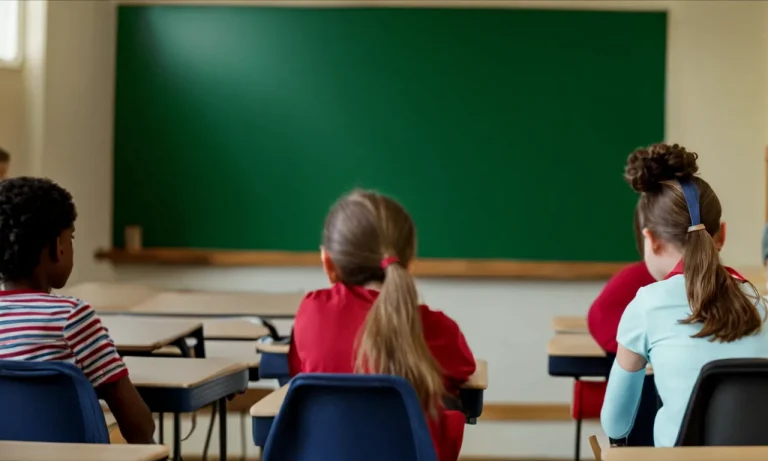Ensuring your child attends school regularly is a critical responsibility as a parent. But what happens if you fail to do so? Can child protective services (CPS) get involved and even remove your child from your home for truancy?
Unfortunately, the answer is yes, though the specific circumstances and state laws vary.
If you’re short on time, here’s a quick answer to your question: CPS can take your child if school truancy is extreme and neglect is suspected, though they typically start with less drastic measures first like parent conferences and truancy petitions.
View this post on Instagram
When Truancy Can Lead to CPS Involvement
Truancy, or chronic absenteeism, can have serious consequences for both the child and their parents. In some cases, it can even result in Child Protective Services (CPS) becoming involved. Truancy is defined as unexcused absences from school, and it is a growing concern in many communities.
Chronic Absenteeism
Chronic absenteeism refers to students who miss a significant number of school days, typically defined as missing 10% or more of the school year. This can be due to a variety of reasons, such as illness, family issues, or lack of transportation.
However, when a child consistently misses school without a valid excuse, it raises concerns about their well-being and educational progress.
When a child is chronically absent, it not only affects their academic performance but also their social and emotional development. Regular school attendance is crucial for a child’s overall growth and success.
It helps them build relationships with their peers, develop important life skills, and access the educational resources they need to thrive.
Educational Neglect
Truancy is often considered a form of educational neglect, which is a type of child neglect. Educational neglect occurs when parents or guardians fail to ensure their child’s attendance at school, resulting in a lack of educational opportunities.
CPS may become involved if they believe a child’s truancy is a result of neglect or if they suspect other forms of abuse or neglect in the child’s home environment.
Child Protective Services’ primary goal is to ensure the safety and well-being of children. When they receive reports or identify patterns of chronic absenteeism, they may investigate the underlying reasons and assess whether intervention is necessary.
CPS may work with the family to address any underlying issues contributing to the child’s truancy and provide support and resources to help improve attendance.
Truancy Laws by State
Truancy laws vary by state, and the consequences for truant behavior can differ as well. In some states, parents may face fines, community service, or even jail time for their child’s truancy. Additionally, schools may be required to report chronic absenteeism to CPS or other relevant authorities.
View this post on Instagram
It is important for parents to be aware of the truancy laws in their state and take steps to ensure their child’s regular school attendance. Schools and communities also play a critical role in addressing truancy by implementing strategies to promote attendance, providing support to families facing challenges, and collaborating with agencies like CPS when necessary.
Steps CPS May Take Before Removing a Child
When it comes to a child’s education, the role of Child Protective Services (CPS) is to ensure that every child receives a proper education. If a child consistently fails to attend school, CPS may intervene to address the situation.
However, CPS typically follows a series of steps before considering removing a child from their home. These steps are designed to work with the parents and provide support rather than immediately resorting to removal.
Parent Conferences
The first step that CPS may take is to schedule parent conferences. They will meet with the parents to discuss the reasons for the child’s truancy and explore potential solutions. During these conferences, CPS may seek to understand any underlying issues that may be contributing to the child’s lack of attendance.
They may also provide resources and guidance to help the parents address the problem effectively.
View this post on Instagram
Attendance Contracts
If the parent conferences do not yield positive results, CPS may suggest implementing an attendance contract. This contract is a written agreement between the parents, the child, and the school, outlining specific attendance goals and consequences for non-compliance.
The contract serves as a way to hold all parties accountable and encourage regular school attendance.
Truancy Petitions and Court Orders
If the child’s attendance does not improve even with an attendance contract, CPS may file a truancy petition with the court. This petition formally brings the issue to the attention of the legal system.
If the court determines that the child’s lack of attendance is due to parental neglect or refusal to ensure school attendance, they may issue a court order requiring the parents to take specific actions to address the truancy issue.
Parent Education Classes
In some cases, CPS may require parents to attend parent education classes focused on the importance of regular school attendance and the consequences of truancy. These classes aim to provide parents with the knowledge and tools necessary to support their child’s education and encourage attendance.
By attending these classes, parents can gain valuable insights and strategies to help improve their child’s attendance.
It is important to note that CPS’s ultimate goal is not to remove a child from their home, but rather to ensure their well-being and educational progress. By following these steps and providing support to parents, CPS aims to address truancy issues and empower families to create a positive educational environment for their children.
When CPS Can Legally Remove a Child for Truancy
Truancy, or the act of a child not attending school regularly, can have serious consequences for both the child and their parents. In some cases, Child Protective Services (CPS) may become involved if a child is consistently not going to school.
However, it is important to understand the circumstances under which CPS can legally remove a child for truancy.
Failure to Comply with Court Orders
If a family has already been involved in legal proceedings regarding truancy and there are court orders in place requiring the child to attend school, failure to comply with these orders can result in CPS taking further action.
It is crucial for parents to understand and follow any court-ordered mandates related to their child’s education. Failure to do so may be seen as a violation of the child’s welfare and may prompt CPS to intervene.
Extreme Chronic Absenteeism
While occasional absences from school are generally not cause for concern, extreme chronic absenteeism can raise red flags for CPS. Each state has its own laws and guidelines regarding what constitutes excessive absences, typically defined as missing a certain number of days within a specified period.
If a child’s attendance record indicates persistent and unexcused absences, CPS may investigate the underlying reasons and determine if intervention is necessary to ensure the child’s well-being and educational progress.
Suspected Abuse or Neglect
In cases where CPS receives reports or has reason to believe that a child’s truancy is connected to abuse or neglect, they may step in to protect the child. Truancy can sometimes be a symptom of larger issues within the home environment, including neglectful or abusive conditions.
CPS will thoroughly investigate any reports or suspicions of abuse or neglect and take appropriate action to ensure the child’s safety and welfare.
It is important for parents and guardians to understand that the primary goal of CPS is to ensure the well-being and safety of children. While truancy alone may not be enough for CPS to remove a child from their home, it can be a factor that prompts further investigation.
If you have concerns or questions about truancy and CPS involvement, it is recommended to reach out to legal professionals or reputable organizations that can provide guidance and support.
Appealing CPS Removal of a Child
When the Child Protective Services (CPS) agency removes a child from their home due to concerns about their education, it can be a distressing situation for both the child and their parents. However, it is important to know that there are steps you can take to appeal the CPS decision and work towards getting your child back home.
Work with Your CPS Caseworker
First and foremost, it is crucial to establish open communication and cooperation with your CPS caseworker. They are there to help you navigate through the process and understand the reasons behind the removal of your child.
By maintaining a respectful and proactive attitude, you can build a positive working relationship with your caseworker, which may increase the chances of finding a resolution.
Ask your caseworker for a detailed explanation of why your child was removed and what steps you can take to address the concerns. Take notes during your conversations and keep a record of all interactions with CPS, as these can be useful if you need to present evidence during an appeal.
Request an Administrative Hearing
If you disagree with the CPS decision to remove your child, you have the right to request an administrative hearing. This is an opportunity for you to present evidence and arguments to an impartial judge who will review the case and make a determination.
To request an administrative hearing, you will need to follow the specific procedures outlined by your state’s CPS agency. Make sure to adhere to all deadlines and provide any requested documentation or evidence.
It is also advisable to seek legal guidance during this process to ensure you are properly prepared and represented.
View this post on Instagram
Consult an Attorney
Consulting with an experienced attorney who specializes in child welfare cases can be invaluable when appealing the CPS removal of your child. An attorney can provide you with legal advice, help you understand your rights, and guide you through the complex legal process.
During your initial consultation with an attorney, be prepared to provide them with all relevant information about your case. This includes any documentation, communication records with CPS, and any evidence you believe supports your position.
An attorney can also help you explore alternative options, such as mediation or family counseling, which may assist in resolving the issues raised by CPS and potentially leading to the return of your child.
Remember, the process of appealing CPS removal of a child can be challenging and emotionally draining. It is important to stay informed, seek support from family and friends, and take care of your own well-being throughout the process.
By working diligently to address the concerns raised by CPS and seeking appropriate legal guidance, you can increase your chances of successfully appealing the removal and being reunited with your child.
Avoiding CPS Involvement and Truancy Issues
Understand Compulsory Attendance Laws
One of the key ways to avoid CPS involvement and truancy issues is to have a clear understanding of the compulsory attendance laws in your area. Each state has its own laws regarding school attendance, and it’s important to familiarize yourself with these regulations.
In most cases, children are required to attend school from a certain age until they reach a specific grade level. By understanding these laws, you can ensure that your child meets the attendance requirements and minimize the risk of CPS intervention.
Address Root Causes Proactively
To prevent truancy issues and potential CPS involvement, it is crucial to address any underlying causes that may contribute to your child’s reluctance to go to school. This could include issues such as bullying, learning difficulties, or social anxiety.
By proactively addressing these root causes, you can create a supportive environment that encourages your child to attend school willingly. It may be helpful to seek guidance from school counselors, teachers, or even professionals if needed.
Communicate with the School
Open and regular communication with your child’s school is an essential step in avoiding CPS involvement. By maintaining a positive relationship with teachers and administrators, you can stay informed about your child’s attendance and address any concerns that may arise.
If your child is facing challenges that affect their school attendance, it is important to inform the school and work together to find solutions. By keeping the lines of communication open, you can demonstrate your commitment to your child’s education and minimize the likelihood of CPS involvement.
Seek Extra Support If Needed
If you find that your child’s attendance issues persist despite your efforts, it may be beneficial to seek extra support. This could involve reaching out to community organizations, educational support programs, or even seeking counseling services.
By collaborating with professionals who specialize in truancy prevention, you can access resources and strategies that can help your child overcome any barriers to school attendance. Remember, seeking support is not a sign of failure but a proactive step towards ensuring your child’s well-being and educational success.
Conclusion
Having your child removed by CPS over truancy issues would be a worst-case scenario for any parent. The good news is that it rarely jumps to that level right away without warning signs and escalating intervention efforts first.
By staying on top of your child’s attendance, communicating with the school, and addressing any underlying issues early, you can likely prevent CPS from ever needing to get involved at all. While truancy and school avoidance is complex, support and solutions are available if you reach out.
With some focus and cooperation, your child’s education and wellbeing can get back on track.






